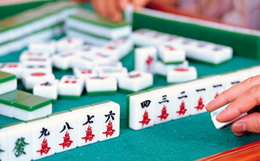
Getting familiar with the dance of the brush

This is how I pushed the door of Gu Gongdu’s classroom for the very first time. If I remember well, there were only three students. Two of them were practicing calligraphy and one of them was painting. But it is Gu Gongdu himself who made a very strong impression on me. The short man was using his brush with vigor and subtleness, so it seemed to be dancing on the paper. Gu Gongdu’s face was focused while expressing pleasure at the same time. I was deeply moved by the contemplation of him practicing calligraphy because it looked incredibly exhilarating. The thing that struck me was how dynamic it was. I practiced drawing quite a bit in my childhood and, although I really enjoyed it, I sometimes felt frustrated because I found it lacked spontaneity. Slightly and progressively altering the lines I drew, spending time on the small details was not boring, but at times, it felt like work instead of play.
Although I have no gift for music, I had been very envious of my musician friends because their art and their moves are one. Because of its dynamic nature, I felt music could express life more than any other kind of art. My own passion was more about graphic arts which usually capture a moment whereas the stream of music is like the very flow of life. But when I saw Gu Gongdu make his brush dance on the paper, I had feelings similar to those when I see a great pianist performing. The moves of the artist, his art and life are all one, creating a deep impression on the public and expressing feelings beyond words. Just seeing Gu Gongdu writing characters gave me the urge to learn. When he noticed that he had a new comer in his small class room, he offered me a “trial” class, but I already knew that it should be much more than a try. This is how I started writing my first clumsy lines and dots with China ink. This was also one of the reasons (not the only one though) why I chose to start studying Chinese geography and language.
From the very beginning, I was happy to learn and always took pleasure in calligraphy. But I realized that my enthusiasm was not shared by most of the other French students. Actually, all of them only wrote a few characters at the beginning of each class, in order to practice their brush strokes, and then they would mainly focus on learning painting. Gu Gongdu had to tell them how important calligraphy was for painting and he was more or less forcing them to practice it a bit so they could also improve their painting skills. It looked exactly like painful exercises a teacher gives to his students who accomplish the task with bad grace. As soon as they finished their short calligraphy session, students would say: “painting, at last!”. They were all very enthusiastic about painting and Chinese culture in general. But they still had no passion for calligraphy. It is probably because although European calligraphy exists, with gothic scripture for instance, it never developed as much as it did in China and people only treated it as a kind of craftsmanship that did not really belong to art.
 |
 |


